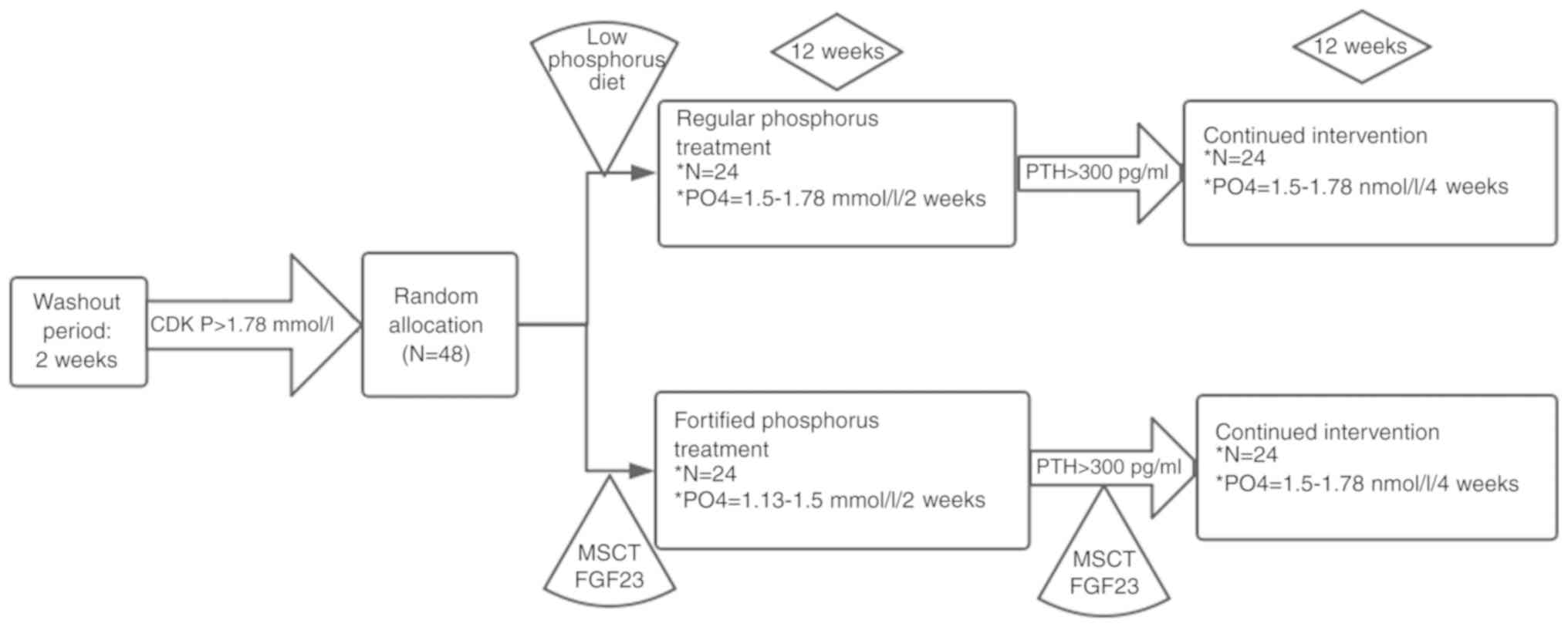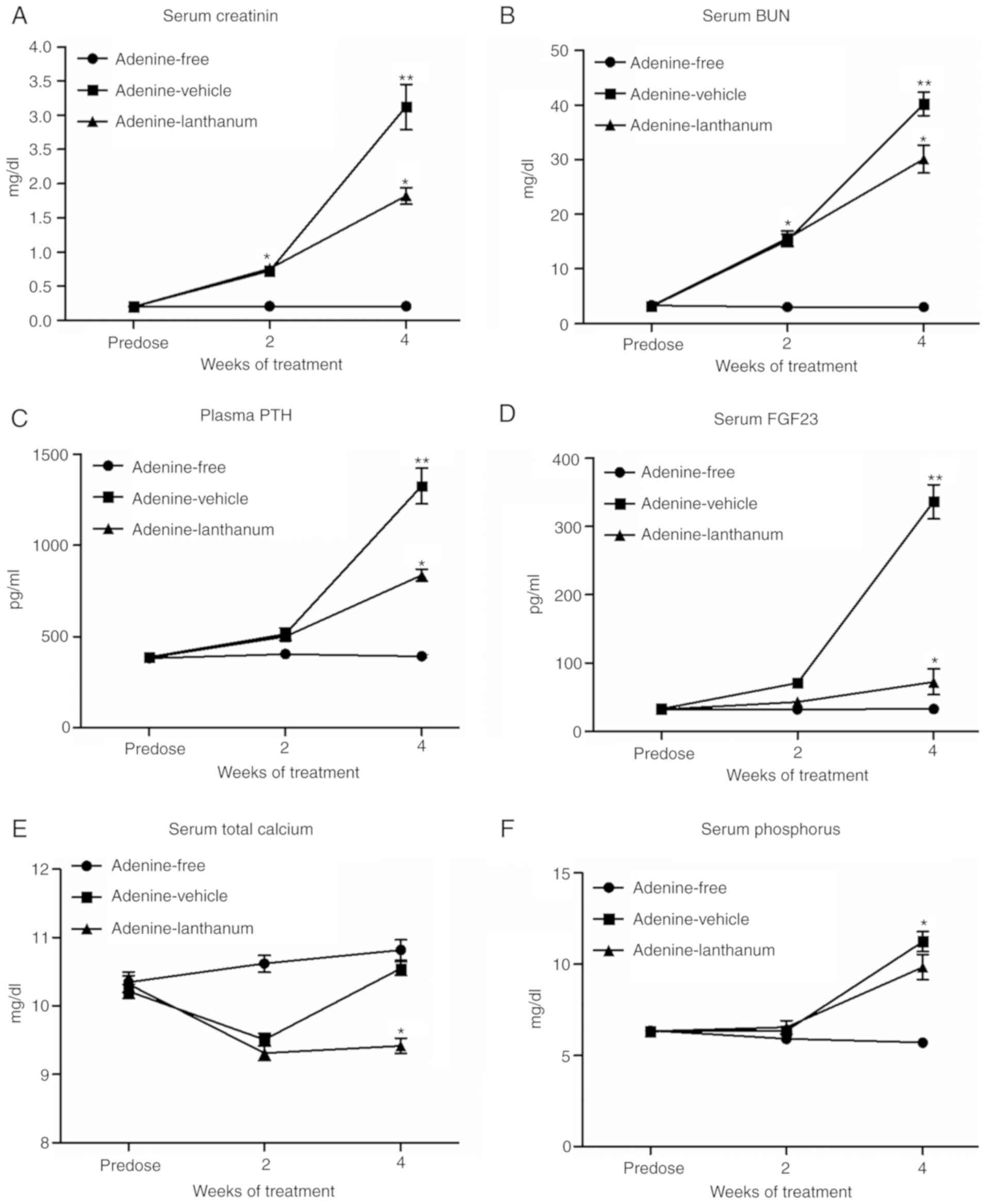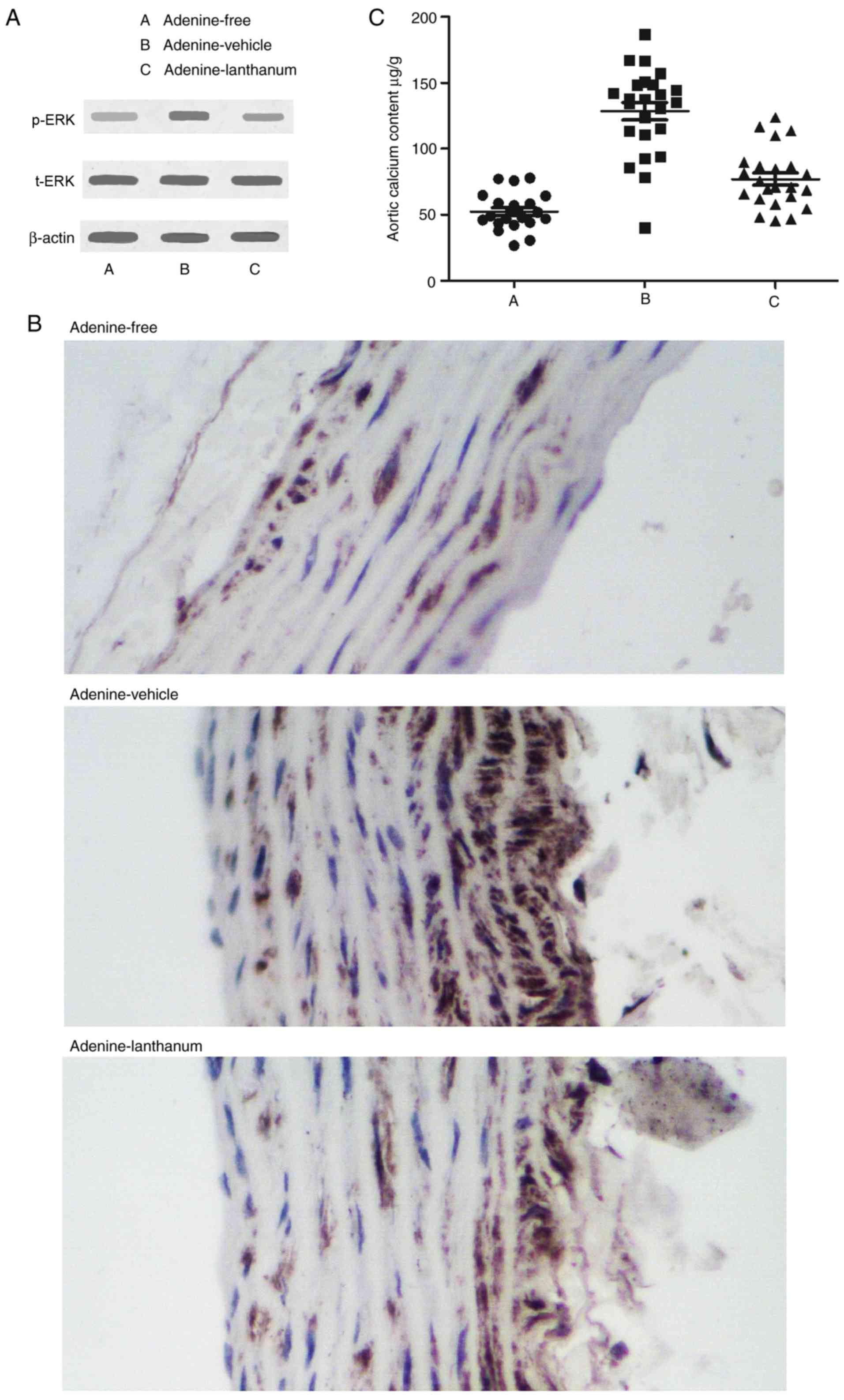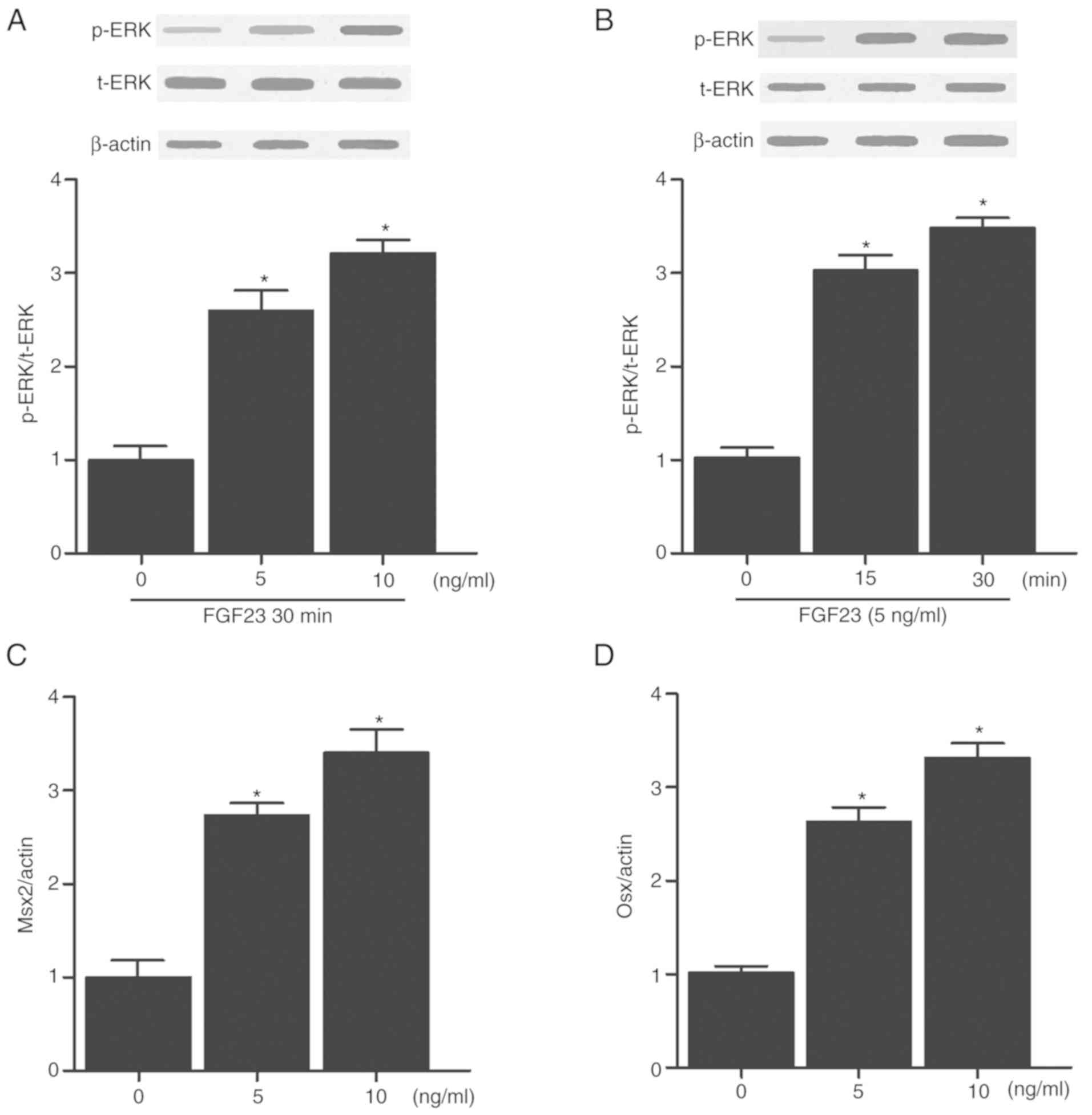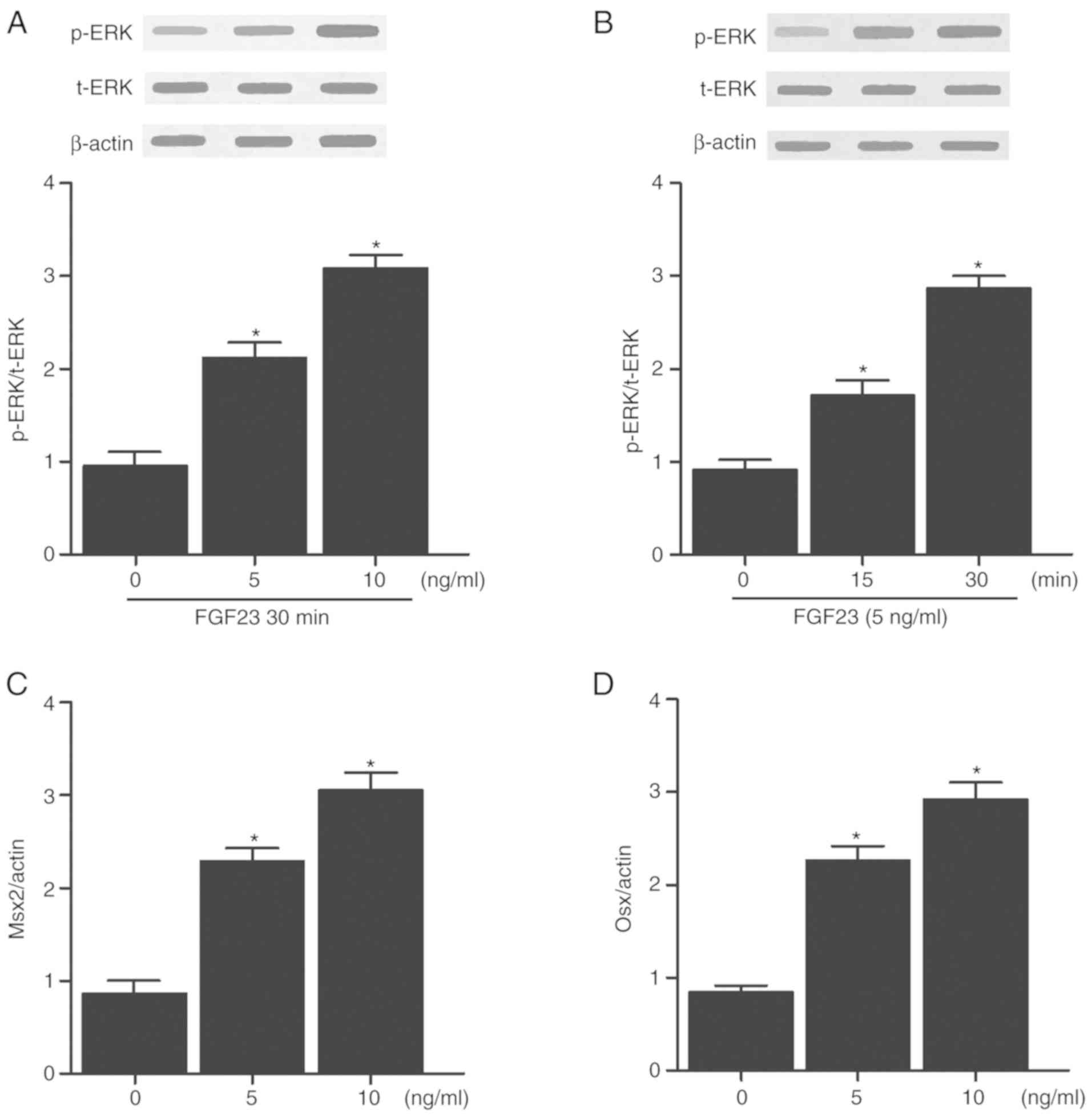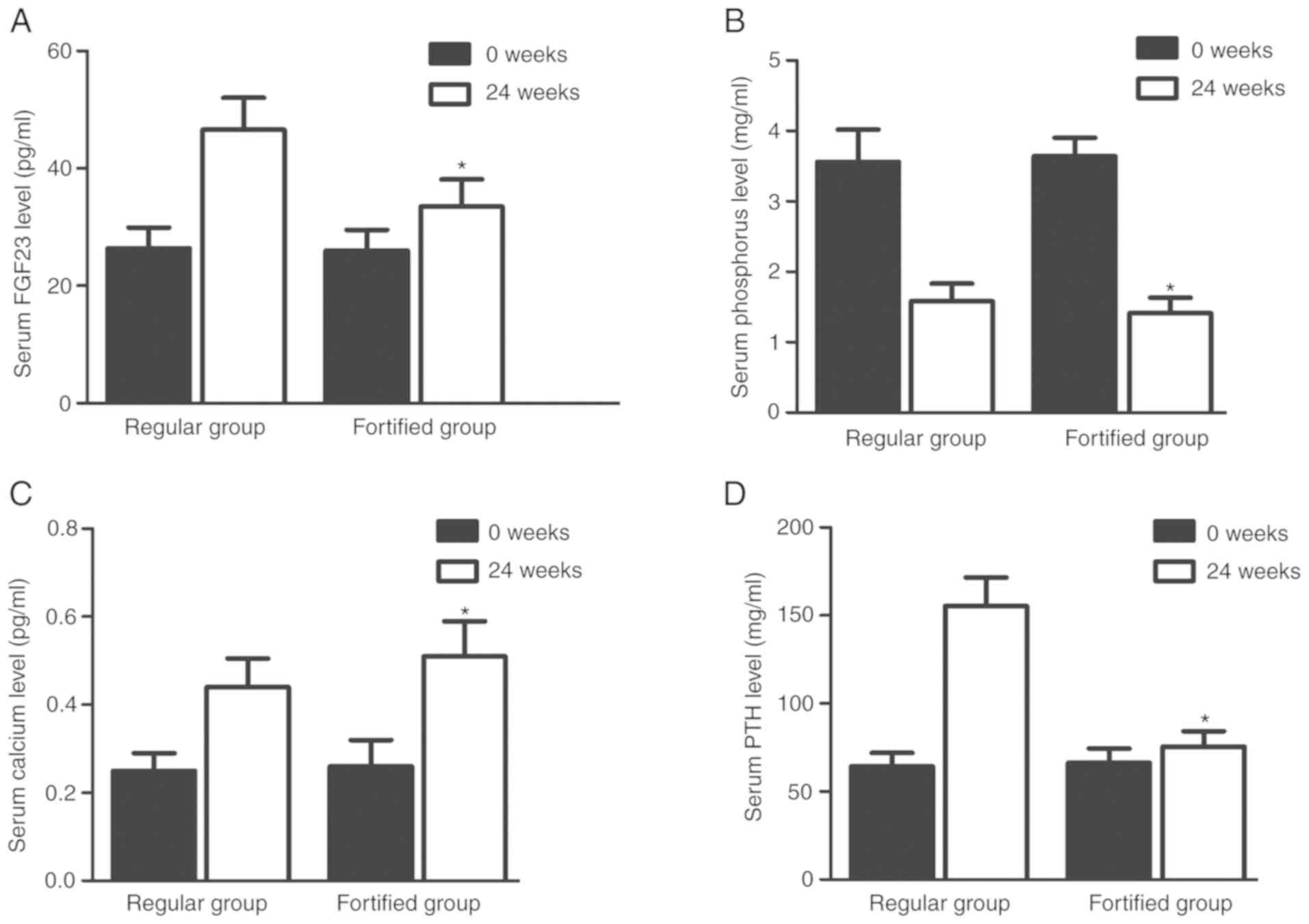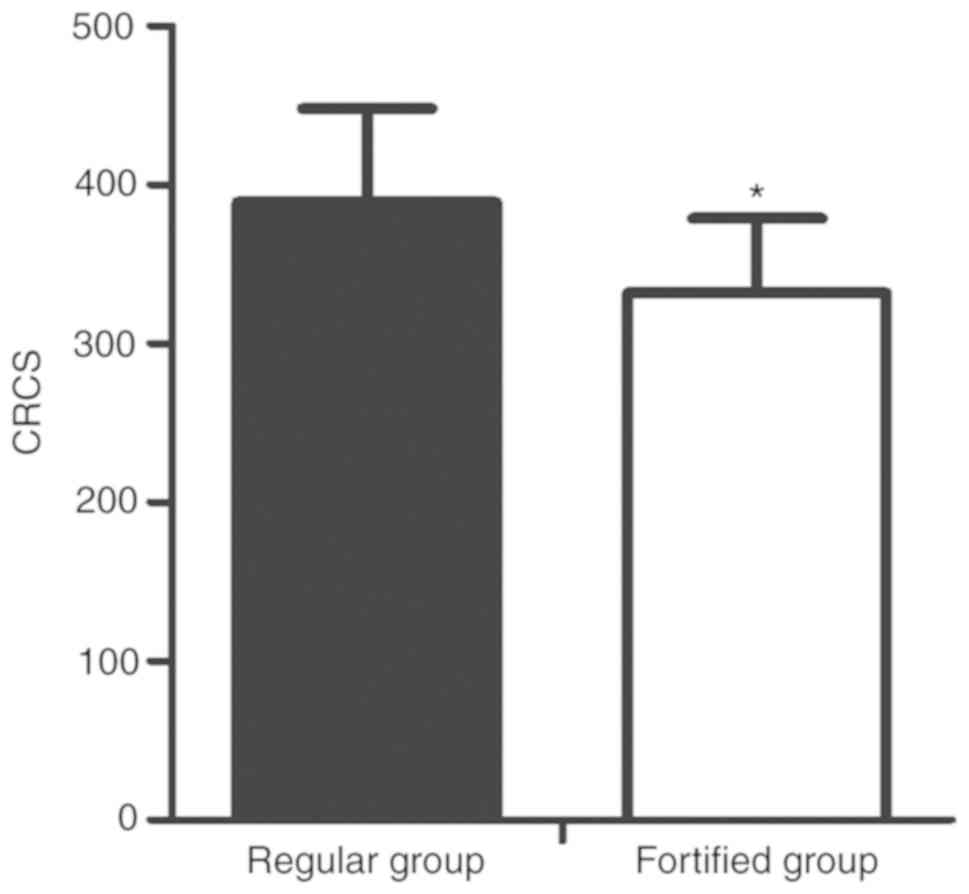|
1
|
Kohl LP, Shroff GR and Herzog CA:
Understanding risks associated with chronic kidney disease:
Translating observational data to patient care. Clin Chem.
59:876–879. 2013. View Article : Google Scholar : PubMed/NCBI
|
|
2
|
Moe SM: Vascular calcification and renal
osteodystrophy relationship in chronic kidney disease. Eur J Clin
Invest. 36(Suppl 2): 51–62. 2006. View Article : Google Scholar : PubMed/NCBI
|
|
3
|
Massy ZA, Mazière C, Kamel S, Brazier M,
Choukroun G, Tribouilloy C, Slama M, Andrejak M and Maziere JC:
Impact of inflammation and oxidative stress on vascular
calcifications in chronic kidney disease. Pediatr Nephrol.
20:380–382. 2005. View Article : Google Scholar
|
|
4
|
Calvo MS and Uribarri J: Public health
impact of dietary phosphorus excess on bone and cardiovascular
health in the general population. Am J Clin Nutr. 98:6–15. 2013.
View Article : Google Scholar : PubMed/NCBI
|
|
5
|
Fukumoto S and Yamashita T: FGF23 is a
hormone-regulating phosphate metabolism-unique biological
characteristics of FGF23. Bone. 40:1190–1195. 2007. View Article : Google Scholar : PubMed/NCBI
|
|
6
|
Ben-Dov IZ, Galitzer H, Lavi-Moshayoff V,
Goetz R, Kuro-o M, Mohammadi M, Sirkis R, Naveh-Many T and Silver
J: The parathyroid is a target organ for FGF23 in rats. J Clin
Invest. 117:4003–4008. 2007.PubMed/NCBI
|
|
7
|
Yamazaki M, Ozono K, Okada T, Tachikawa K,
Kondou H, Ohata Y and Michigami T: Both FGF23 and extracellular
phosphate activate Raf/MEK/ERK pathway via FGF receptors in HEK293
cells. J Cell Biochem. 111:1210–1221. 2010. View Article : Google Scholar : PubMed/NCBI
|
|
8
|
Gutiérrez OM, Mannstadt M, Isakova T,
Rauh-Hain JA, Tamez H, Shah A, Smith K, Lee H, Thadhani R, Jüppner
H and Wolf M: Fibroblast growth factor 23 and mortality among
patients undergoing hemodialysis. N Engl J Med. 359:584–592. 2008.
View Article : Google Scholar : PubMed/NCBI
|
|
9
|
Jean G, Bresson E, Terrat JC, Vanel T,
Hurot JM, Lorriaux C, Mayor B and Chazot C: Peripheral vascular
calcification in long-haemodialysis patients: Associated factors
and survival consequences. Nephrol Dial Transplant. 24:948–955.
2009. View Article : Google Scholar
|
|
10
|
Jimbo R, Kawakami-Mori F, Mu S, Hirohama
D, Majtan B, Shimizu Y, Yatomi Y, Fukumoto S, Fujita T and
Shimosawa T: Fibroblast growth factor 23 accelerates
phosphate-induced vascular calcification in the absence of Klotho
deficiency. Kidney Int. 85:1103–1111. 2014. View Article : Google Scholar
|
|
11
|
Asadur R, Daisuke Y, Abu S, Kento K,
Hirofumi H, Daisuke N and Akira N: A novel approach to
adenine-induced chronic kidney disease associated anemia in
rodents. PLoS One. 13:e01925312018. View Article : Google Scholar
|
|
12
|
World Medical Association: World medical
association declaration of helsinki: Ethical principles for medical
research involving human subjects. JAMA. 310:2191–2194. 2013.
View Article : Google Scholar : PubMed/NCBI
|
|
13
|
Lim K, Lu TS, Molostvov G, Lee C, Lam FT,
Zehnder D and Hsiao LL: Vascular Klotho deficiency potentiates the
development of human artery calcification and mediates resistance
to fibroblast growth factor 23. Circulation. 125:2243–2255. 2012.
View Article : Google Scholar : PubMed/NCBI
|
|
14
|
National Research Council (US) Committee
for the Update of the Guide for the Care and Use of Laboratory
Animals: Guide for the Care and Use of Laboratory Animals: Guide
for the Care and Use of Laboratory Animals. 8th edition. National
Academies Press (US); Washington, DC: 2011
|
|
15
|
Shima WN, Ali AM, Subramani T, Mohamed
Alitheen NB, Hamid M, Samsudin AR and Yeap SK: Rapid growth and
osteogenic differentiation of mesenchymal stem cells isolated from
human bone marrow. Exp Ther Med. 9:2202–2206. 2015. View Article : Google Scholar : PubMed/NCBI
|
|
16
|
Hunt JL, Fairman R, Mitchell ME, Carpenter
JP, Golden M, Khalapyan T, Wolfe M, Neschis D, Milner R, Scoll B,
et al: Bone formation in carotid plaques: A clinicopathological
study. Stroke. 33:1214–1219. 2002. View Article : Google Scholar : PubMed/NCBI
|
|
17
|
Giachelli CM: The emerging role of
phosphate in vascular calcification. Kidney Int. 75:890–897. 2009.
View Article : Google Scholar : PubMed/NCBI
|
|
18
|
Goodman WG, Goldin J, Kuizon BD, Yoon C,
Gales B, Sider D, Wang Y, Chung J, Emerick A, Greaser L, et al:
Coronary-artery calcification in young adults with end-stage renal
disease who are undergoing dialysis. N Engl J Med. 342:1478–1483.
2000. View Article : Google Scholar : PubMed/NCBI
|
|
19
|
Blacher J, Guerin AP, Pannier B, Marchais
SJ and London GM: Arterial calcifications, arterial stiffness, and
cardiovascular risk in end-stage renal disease. Hypertension.
38:938–942. 2001. View Article : Google Scholar : PubMed/NCBI
|
|
20
|
Prié D, Torres PU and Friedlander G:
Latest findings in phosphate homeostasis. Kidney Int. 75:882–889.
2009. View Article : Google Scholar : PubMed/NCBI
|
|
21
|
Isakova T, Wahl P, Vargas GS, Gutiérrez
OM, Scialla J, Xie H, Appleby D, Nessel L, Bellovich K, Chen J, et
al: Fibroblast growth factor 23 is elevated before parathyroid
hormone and phosphate in chronic kidney disease. Kidney Int.
79:1370–1378. 2011. View Article : Google Scholar : PubMed/NCBI
|
|
22
|
Stevens LA, Djurdjev O, Cardew S, Cameron
EC and Levin A: Calcium, phosphate, and parathyroid hormone levels
in combination and as a function of dialysis duration predict
mortality: Evidence for the complexity of the association between
mineral metabolism and outcomes. J Am Soc Nephrol. 15:770–779.
2004. View Article : Google Scholar : PubMed/NCBI
|
|
23
|
Lynch KE, Lynch R, Curhan GC and Brunelli
SM: Prescribed dietary phosphate restriction and survival among
hemodialysis patients. Clin J Am Soc Nephrol. 6:620–629. 2011.
View Article : Google Scholar :
|
|
24
|
Kestenbaum B: Phosphate metabolism in the
setting of chronic kidney disease: Significance and recommendations
for treatment. Semin Dial. 20:286–294. 2007. View Article : Google Scholar : PubMed/NCBI
|
|
25
|
Liu S, Guo R, Simpson LG, Xiao ZS, Burnham
CE and Quarles LD: Regulation of fibroblastic growth factor 23
expression but not degradation by PHEX. J Biol Chem.
278:37419–37426. 2003. View Article : Google Scholar : PubMed/NCBI
|
|
26
|
Quarles LD: Endocrine functions of bone in
mineral metabolism regulation. J Clin Invest. 118:3820–3828. 2008.
View Article : Google Scholar : PubMed/NCBI
|
|
27
|
Kurosu H, Ogawa Y, Miyoshi M, Yamamoto M,
Nandi A, Rosenblatt KP, Baum MG, Schiavi S, Hu MC, Moe OW and
Kuro-o M: Regulation of fibroblast growth factor-23 signaling by
klotho. J Biol Chem. 281:6120–6123. 2006. View Article : Google Scholar : PubMed/NCBI
|
|
28
|
Beckman MJ, Tadikonda P, Werner E, Prahl
J, Yamada S and DeLuca HF: Human 25-hydroxyvitamin
D3-24-hydroxylase, a multicatalytic enzyme. Biochemistry.
35:8465–8472. 1996. View Article : Google Scholar : PubMed/NCBI
|
|
29
|
Goetz R and Mohammadi M: Exploring
mechanisms of FGF signalling through the lens of structural
biology. Nat Rev Mol Cell Biol. 14:166–180. 2013. View Article : Google Scholar : PubMed/NCBI
|
|
30
|
Craver L, Marco MP, Martínez I, Rue M,
Borràs M, Martín ML, Sarró F, Valdivielso JM and Fernández E:
Mineral metabolism parameters throughout chronic kidney disease
stages 1-5-achievement of K/DOQI target ranges. Nephrol Dial
Transplant. 22:1171–1176. 2007. View Article : Google Scholar : PubMed/NCBI
|
|
31
|
Dërmaku-Sopjani M, Sopjani M, Saxena A,
Shojaiefard M, Bogatikov E, Alesutan I, Eichenmüller M and Lang F:
Downregulation of NaPi-IIa and NaPi-IIb Na-coupled phosphate
transporters by coexpression of Klotho. Cell Physiol Biochem.
28:251–258. 2011. View Article : Google Scholar : PubMed/NCBI
|
|
32
|
Ikushima M, Rakugi H, Ishikawa K, Maekawa
Y, Yamamoto K, Ohta J, Chihara Y, Kida I and Ogihara T:
Anti-apoptotic and anti-senescence effects of Klotho on vascular
endothelial cells. Biochem Biophys Res Commun. 339:827–832. 2006.
View Article : Google Scholar
|
|
33
|
Eliopoulos AG, Wang CC, Dumitru CD and
Tsichlis PN: Tpl2 transduces CD40 and TNF signals that activate ERK
and regulates IgE induction by CD40. EMBO J. 22:3855–3864. 2003.
View Article : Google Scholar : PubMed/NCBI
|
|
34
|
El-Najjar N, Chatila M, Moukadem H,
Vuorela H, Ocker M, Gandesiri M, Schneider-Stock R and
Gali-Muhtasib H: Reactive oxygen species mediate
thymoquinone-induced apoptosis and activate ERK and JNK signaling.
Apoptosis. 15:183–195. 2010. View Article : Google Scholar
|
|
35
|
Lannuzel A, Barnier JV, Hery C, Huynh VT,
Guibert B, Gray F, Vincent JD and Tardieu M: Human immunodeficiency
virus type 1 and its coat protein gp120 induce apoptosis and
activate JNK and ERK mitogen-activated protein kinases in human
neurons. Ann Neurol. 42:847–856. 2010. View Article : Google Scholar
|
|
36
|
Thiel MJ, Schaefer CJ, Lesch ME, Mobley
JL, Dudley DT, Tecle H, Barrett SD, Schrier DJ and Flory CM:
Central role of the MEK/ERK MAP kinase pathway in a mouse model of
rheumatoid arthritis: Potential proinflammatory mechanisms.
Arthritis Rheum. 56:3347–3357. 2007. View Article : Google Scholar : PubMed/NCBI
|
|
37
|
Xu L, Peng H, Wu D, Hu K, Goldring MB,
Olsen BR and Li Y: Activation of the discoidin domain receptor 2
induces expression of matrix metalloproteinase 13 associated with
osteoarthritis in mice. J Biol Chem. 280:548–555. 2005. View Article : Google Scholar
|
|
38
|
Wallin R, Wajih N, Greenwood GT and Sane
DC: Arterial calcification: A review of mechanisms, animal models,
and the prospects for therapy. Med Res Rev. 21:274–301. 2001.
View Article : Google Scholar : PubMed/NCBI
|
|
39
|
You H, Yang H, Zhu Q, Li M, Xue J, Gu Y,
Lin S and Ding F: Advanced oxidation protein products induce
vascular calcification by promoting osteoblastic
trans-differentiation of smooth muscle cells via oxidative stress
and ERK pathway. Ren Fail. 31:313–319. 2009. View Article : Google Scholar : PubMed/NCBI
|















